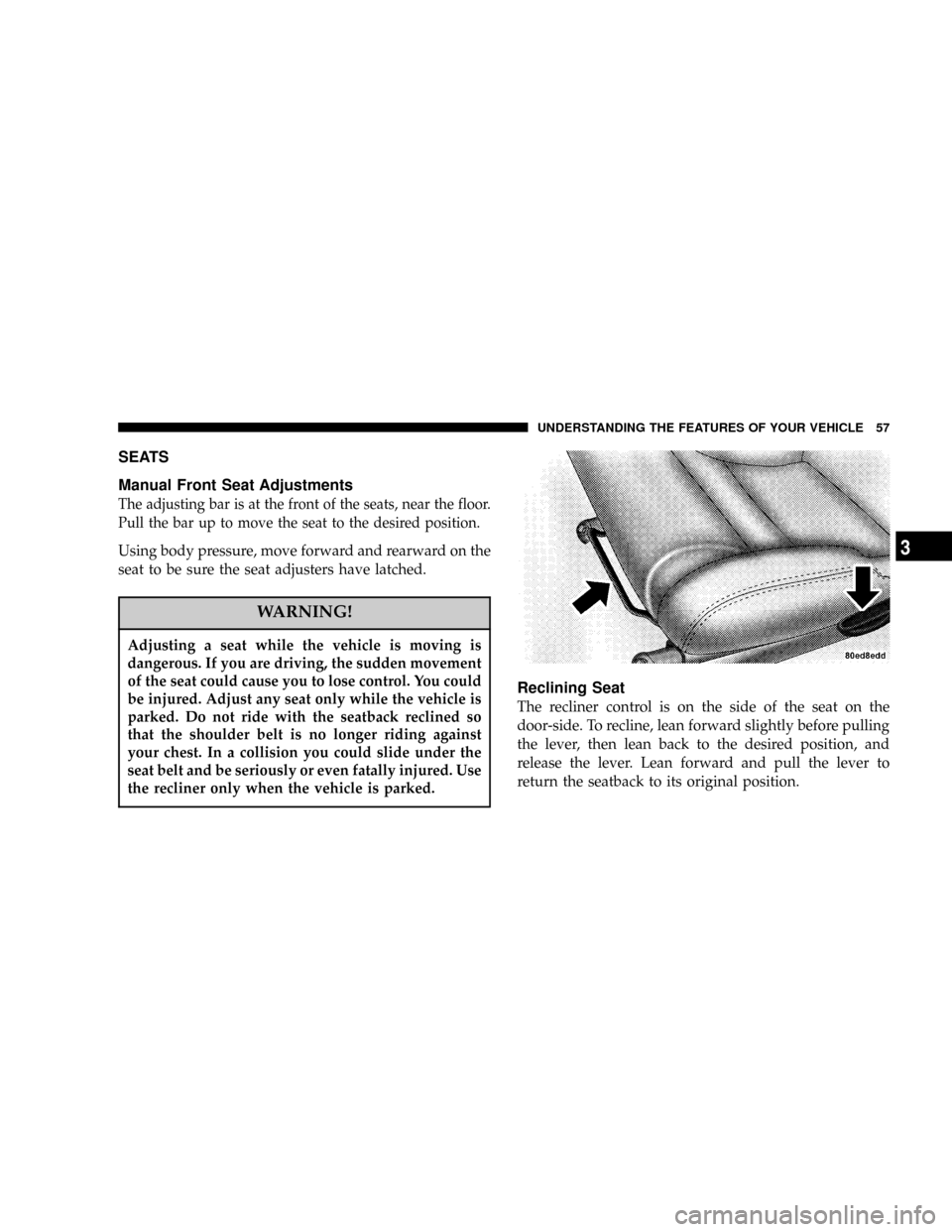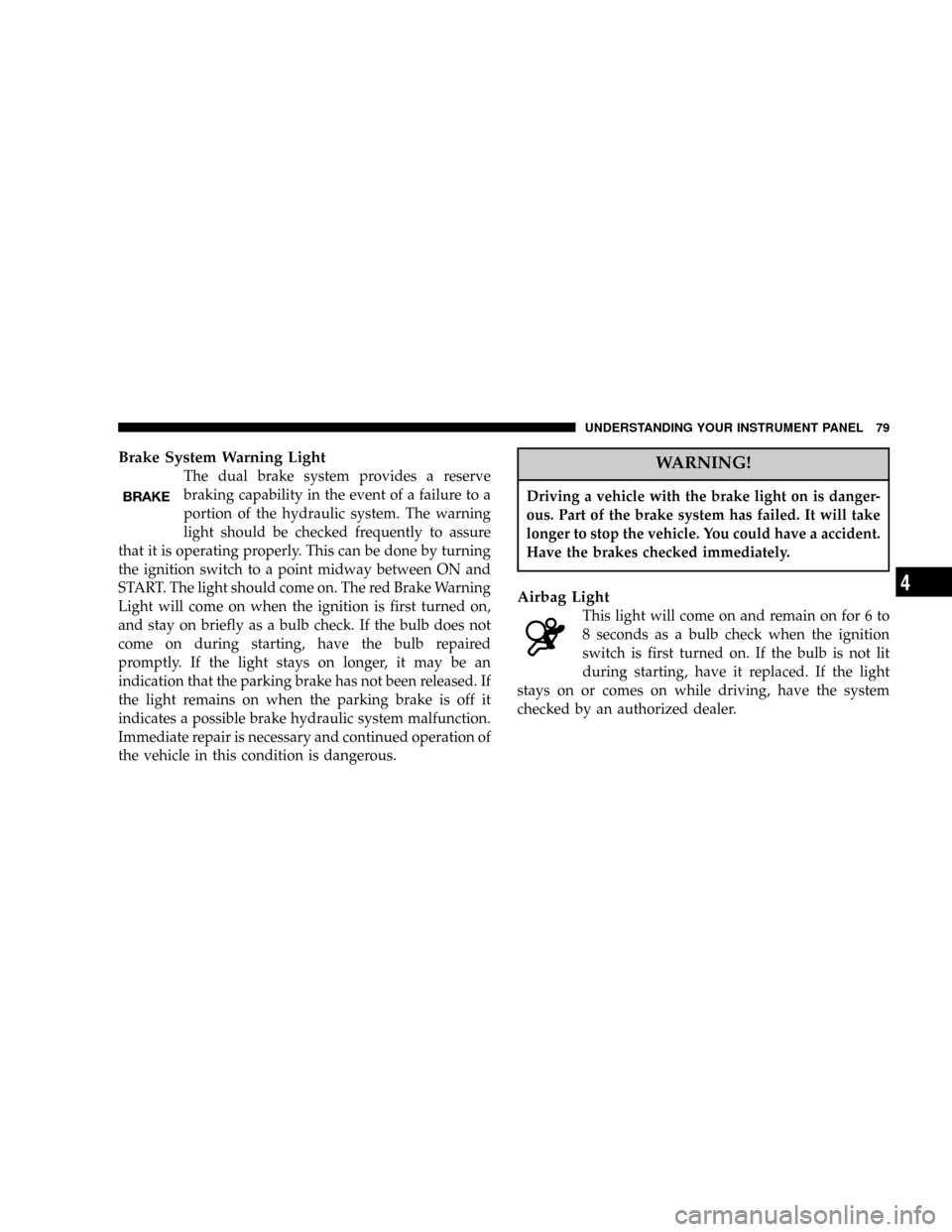warning light DODGE VIPER 2004 ZB / 2.G Owners Manual
[x] Cancel search | Manufacturer: DODGE, Model Year: 2004, Model line: VIPER, Model: DODGE VIPER 2004 ZB / 2.GPages: 236, PDF Size: 4.18 MB
Page 30 of 236

WARNING!
A lap belt worn too high can increase the risk of
internal injury in a collision. The belt forces won't
be at the strong hip and pelvic bones, but across your
abdomen. Always wear the lap belt as low as pos-
sible and keep it snug.
7. Position the shoulder belt on your chest so that it is
comfortable and not resting on your neck. The retractor
will withdraw any slack in the belt.
WARNING!
A twisted belt can't do its job as well. In a collision
it could even cut into you. Be sure the belt is straight.
If you can't straighten a belt in your vehicle, take it
to your dealer and have it fixed.
8. To release the belt, push the red button marked PRESS
on the buckle. The belt will automatically retract to its
stowed position. If necessary, slide the latch plate down
the webbing to allow it to retract fully.
Enhanced Driver Seat Belt Reminder System
(BeltAlertŸ)
If the driver's seat belt has not been buckled within 60
seconds of starting the vehicle and if the vehicle speed is
greater than 5 mph (8 km/h), the Enhanced Warning
System (BeltAlertŸ) will alert the driver to buckle their
seat belt. The driver should also instruct all other occu-
pants to buckle their seat belts. Once the warning is
triggered, the Enhanced Warning System (BeltAlertŸ)
will continue to chime and flash the Seat Belt Warning
Light for 96 seconds or until the driver's seat belt is
buckled. The Enhanced Warning System (BeltAlertŸ)
will be reactivated if the driver's seat belt is unbuckled
for more than 10 seconds and the vehicle speed is greater
than 5 mph (8 km/h).
30 THINGS TO KNOW BEFORE STARTING YOUR VEHICLE
Page 31 of 236

The Enhanced Warning System (BeltAlertŸ) can be en-
abled or disabled by your authorized dealer or by
following these steps:
NOTE:The following steps must occur within the first
60 seconds of the ignition switch being turned to the ON
or START position. DaimlerChrysler does not recom-
mend deactivating the Enhanced Warning System
(BeltAlert).
1. Turn the ignition switch to the OFF position and
buckle the driver's seat belt.
2. Start the engine and wait for the Seat Belt Warning
Light to turn off.
3. Within 60 seconds of starting the vehicle, unbuckle
and then re-buckle the driver's seat belt at least three
times within 10 seconds, ending with the seat belt
buckled.4. Turn off the engine. A single chime will sound to
signify that you have successfully completed the pro-
gramming.
The Enhanced Warning System (BeltAlertŸ) can be reac-
tivated by repeating this procedure.
NOTE:Although the Enhanced Warning System (BeltA-
lertŸ) has been deactivated, the Seat Belt Warning Light
will continue to illuminate while the driver's seat belt
remains unbuckled.
Six Point Belt System - If equipped
This six point belt system meets SCCA standards and
should be only used when engaged in related perfor-
mance driving events. The standard lap/shoulder belt
should be used whenever the vehicle is operated on the
street.
THINGS TO KNOW BEFORE STARTING YOUR VEHICLE 31
2
Page 41 of 236

all of the items listed above except the knee bolster, the
instrument panel, and the steering wheel and column.
The Diagnostic Unit also turns on the AIRBAG light in
the instrument panel for 6 to 8 seconds when the
ignition is first turned on, then turns the light off. If it
detects a malfunction in any part of the system, it turns
on the light either momentarily or continuously.
²The Airbag/Inflator Units are in the center of the
steering wheel and in the instrument panel. The words
SRS/AIRBAG are embossed on the airbag covers.
WARNING!
Ignoring the AIRBAG light in your instrument panel
could mean you won't have the airbags to protect
you in a collision. If the light does not come on, stays
on after you start the vehicle, or if it comes on as you
drive, have the airbag system checked right away.
WARNING!
Do not put anything on or around the airbag covers
or attempt to manually open them. You may damage
the airbags and you could be injured because the
airbags are not there to protect you. These protective
covers for the airbag cushions are designed to open
only when the airbags are inflating.
²When the crash sensors detect an impact requiring the
airbags, they signal the inflator units. A large quantity
of non toxic nitrogen gas is generated to inflate the
airbags. The airbag covers separate and fold out of the
way as the airbags inflate to their full size. The airbags
fully inflate in about 50 milliseconds. This is only
about half of the time it takes you to blink your eyes.
The airbags then quickly deflate while helping to
restrain the driver and right front passenger. The
airbag gas is vented through the airbag material
THINGS TO KNOW BEFORE STARTING YOUR VEHICLE 41
2
Page 45 of 236

To Turn On The Passenger Airbag:
²Place the ignition key in the on/off switch, turn the
key counterclockwise, and remove the key from the
switch. This will turn on the passenger side airbag.
The light on the instrument panel will be off when the
ignition switch is turned to the ON position.
WARNING!
The airbag may malfunction and serious injury
could result if key is left in the airbag shut off
switch. Always remove the key.
Maintaining Your Airbag System
WARNING!
²Modifications to any part of the airbag system
could cause it to fail when you need it. You could
be injured because the airbag is not there to
protect you. Do not modify the components or
wiring, including adding any kind of badges or
stickers to the airbag covers. Do not modify the
front bumper or vehicle body structure.
²You need proper knee impact protection in a
collision. Do not mount or locate any aftermarket
equipment on or behind the knee impact bolsters.
²You can be injured if you are too close to either
airbag cover when the airbags inflate. It is dan-
gerous to try to repair any part of the airbag
system yourself. Don't try to repair the airbag
system. Be sure to tell anyone who works on your
vehicle that it has airbags.
THINGS TO KNOW BEFORE STARTING YOUR VEHICLE 45
2
Page 56 of 236

NOTE:Place the mirror selector switch in the center
(neutral) position to prevent accidental movement of the
mirrors.
Mirror Adjustment
Outside Mirror Ð Driver's Side
Adjust the outside mirror to center on the adjacent lane of
traffic, with a slight overlap of the view obtained on the
inside mirror.
Right Side Mirror
Adjust the convex outside mirror so you can just see the
side of your vehicle. This type of mirror will give a much
wider view to the rear, and especially of the lane next to
your vehicle.
WARNING!
Vehicles and other objects seen in the right side
convex mirror will look smaller and farther away
than they really are. Relying too much on your right
side mirror could cause you to collide with another
vehicle or other object. Use your inside mirror when
judging the size or distance of a vehicle seen in this
convex mirror.
56 UNDERSTANDING THE FEATURES OF YOUR VEHICLE
Page 57 of 236

SEATS
Manual Front Seat Adjustments
The adjusting bar is at the front of the seats, near the floor.
Pull the bar up to move the seat to the desired position.
Using body pressure, move forward and rearward on the
seat to be sure the seat adjusters have latched.
WARNING!
Adjusting a seat while the vehicle is moving is
dangerous. If you are driving, the sudden movement
of the seat could cause you to lose control. You could
be injured. Adjust any seat only while the vehicle is
parked. Do not ride with the seatback reclined so
that the shoulder belt is no longer riding against
your chest. In a collision you could slide under the
seat belt and be seriously or even fatally injured. Use
the recliner only when the vehicle is parked.
Reclining Seat
The recliner control is on the side of the seat on the
door-side. To recline, lean forward slightly before pulling
the lever, then lean back to the desired position, and
release the lever. Lean forward and pull the lever to
return the seatback to its original position.
UNDERSTANDING THE FEATURES OF YOUR VEHICLE 57
3
Page 75 of 236

Turn Signal Indicators
The arrows will flash in unison with the corresponding
exterior turn signal when using the signal lever.
Hazard Indicator
Both turn signal arrows will flash in unison with all front
and rear turn signals when the hazard warning switch is
used.
NOTE:Leaving the hazard flashers on for extended
periods of time will wear down the battery.
Message Center
Message Center Components
Anti-Lock Warning Light
The amber ABS Warning Light will come on when
the ignition is first turned on, and stay on briefly
as a bulb check. If the bulb does not come on during
starting, have the bulb repaired promptly. This light also
illuminates to indicate that the Antilock Brake System
self-check is in process at vehicle start-up. If the light
remains on after start-up, or comes on and stays on at
road speeds, it may indicate that the ABS has detected a
malfunction or has become inoperative. In this case, the
system reverts to standard non-antilock brakes. Turn the
engine off and on again to reset the Antilock Brake
System. If the light remains on, see your authorized
dealer. If both the red BRAKE and amber ABS warning
lights are on and the parking brake is fully released, see
your authorized dealer immediately.
UNDERSTANDING YOUR INSTRUMENT PANEL 75
4
Page 76 of 236

WARNING!
If both ABS and/or Brake Warning lamps become
illuminated, please seek service immediately! Your
Viper will have diminished braking capability and
control if ABS and/or service brake systems are not
working properly. Have your brake system serviced
immediately.
Skip Shift Indicator
This indicator is located in the Tachometer. There
are two LED lights. The amber LED light will come
on when you are being prevented from shifting from First
to Second or Third gear. The tachometer's shift arrow also
houses a red LED light that activates when the tachom-
eter gauge pointer goes above 5600 RPM and it shuts off
when the tachometer pointer falls below 5500 RPM. The
indicator serves as a visual aid to shift before reaching the
red line.
Malfunction Indicator Light
This light is part of an onboard diagnostic
system called OBD II which provides in-field
emissions inspection tests required in some
states. If certain self-diagnostic monitors are
not complete, the light starts flashing 14 seconds after the
key is switched on and will continue to flash for approxi-
mately 11 seconds. If the OBD II monitors have com-
pleted, the malfunction indicator lamp will not flash as
described above.
The light will illuminate when the key is turned to the
ON position before engine start. The light will remain on
steady until the engine has started. If the bulb does not
come on when turning the key from OFF to ON have the
condition checked promptly. The light will turn off after
the engine has started, unless a malfunction is present.
76 UNDERSTANDING YOUR INSTRUMENT PANEL
Page 77 of 236

CAUTION!
Prolonged driving with the light on could cause
further damage to the emission control system. It
could also affect fuel economy and driveability. The
vehicle must be serviced before any state emissions
tests can be performed.
If the light is flashing, severe catalytic converter damage
and power loss will soon occur. Immediate service is
required.
If the gas cap is not secured properly, the light may come
on. Be sure the gas cap is tightened every time you add
fuel.
High Beam Indicator
This light shows that the headlights are on high
beam. Pull the turn signal lever toward the steer-
ing wheel to switch the headlights from high or low
beam.
Seat Belt Indicator Light
This system alerts the driver to fasten the seat belt
if not done so within 60 seconds of starting the
vehicle and if the vehicle is moving faster than 5
mph (8 km/h). The system will cause a chime to sound
repeatedly and will flash the seat belt warning light for 96
seconds or until the driver's seat belt is fastened. The
reminder system will be reactivated if the driver's seat
belt is unfastened for more than 10 seconds and the
vehicle speed is greater than 5 mph (8 km/hr). Refer to
Enhanced Seat Belt Use Reminder System (BeltAlertŸ) in
the Occupant Restraints section for deactivating the
system.
UNDERSTANDING YOUR INSTRUMENT PANEL 77
4
Page 79 of 236

Brake System Warning Light
The dual brake system provides a reserve
braking capability in the event of a failure to a
portion of the hydraulic system. The warning
light should be checked frequently to assure
that it is operating properly. This can be done by turning
the ignition switch to a point midway between ON and
START. The light should come on. The red Brake Warning
Light will come on when the ignition is first turned on,
and stay on briefly as a bulb check. If the bulb does not
come on during starting, have the bulb repaired
promptly. If the light stays on longer, it may be an
indication that the parking brake has not been released. If
the light remains on when the parking brake is off it
indicates a possible brake hydraulic system malfunction.
Immediate repair is necessary and continued operation of
the vehicle in this condition is dangerous.WARNING!
Driving a vehicle with the brake light on is danger-
ous. Part of the brake system has failed. It will take
longer to stop the vehicle. You could have a accident.
Have the brakes checked immediately.
Airbag Light
This light will come on and remain on for 6 to
8 seconds as a bulb check when the ignition
switch is first turned on. If the bulb is not lit
during starting, have it replaced. If the light
stays on or comes on while driving, have the system
checked by an authorized dealer.
UNDERSTANDING YOUR INSTRUMENT PANEL 79
4